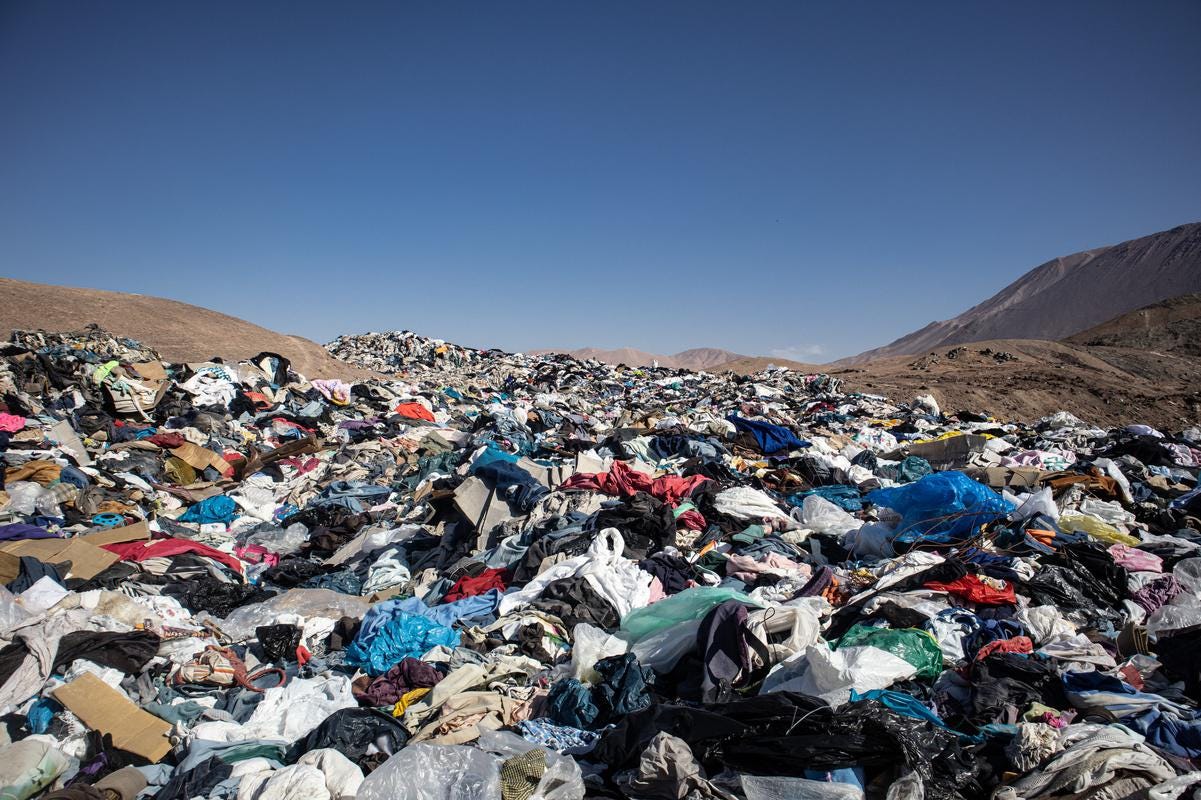
Used clothes in a landfill in Chile’s Atacama Desert. (Photo: Antonio Cossio/dpa)
Could you make do with 85 articles of clothing? It certainly sounds achievable.
A new report from the Hot or Cool Institute, a sustainability-focused think tank, suggests that 85 garments should be enough for the average resident of a high-income country with four seasons. This 85-garment threshold is also in keeping with the Paris Agreement’s goal of limiting temperature rise to 1.5°C above pre-industrial levels.
Fashion is already one of the world’s biggest producers of greenhouse gas emissions. This is set to increase further as prices continue to drop, consumption ratchets up, and the wear time of each garment plummets.
Transformation of the fashion industry is needed to avert the worst climate impacts. And this new research suggests that the transformation can be achieved equitably: ensuring that everyone has enough clothing, and enough income from producing clothing, for their needs.
Fair
The report “Unfit, Unfair, Unfashionable: Resizing Fashion for a Fair Consumption Space” focuses on the G20 countries, finding that Australia has the highest fashion consumption footprint (503 kg of CO2 equivalent per year), with Australians throwing away almost as much clothing as they buy each year. In contrast, India has the lowest in the G20 (22 kg). In Indonesia, 74% don’t have as much clothing as they need.
While these are enormous divergences, it’s not just inequality between countries that matters. Inequality within countries is also significant. According to “Unfit, Unfair, Unfashionable,” the fashion habits of middle- and high-income consumers in Indonesia, though these are a minority, are out of sync with keeping to a 1.5°C temperature rise. More broadly (and prepare here for an onslaught of the number 20), the richest 20% of people across the G20 countries emit 20 times more from fashion, on average, than the poorest 20%.
MORE FOR YOU
There’s plenty of classist shaming of the spending habits of less affluent people; news producers love to gawk at hordes of people queuing outside down-market retailers during sales, for instance. But clearly the richest are doing outsized damage to the environment.
Among the relatively well-off, there’s a pretty simple fix, which sustainability advocates have been shouting from the rooftops for years: buy less, and buy better. Buying less would lessen the climate impacts of producing, washing, and disposing of clothes; and buying better would help to distribute profits into the hands of garment workers. There’s more than enough to go around, if we even out the spread.
The single best way for people in rich countries to reduce the climate impacts of fashion is to buy fewer new clothes, emphasizes Lewis Akenji, managing director of the Hot or Cool Institute. The other measures – like buying secondhand, choosing more sustainable fabrics, renting clothes, and washing clothing less – are important, but pale in comparison to the sheer brute power of overconsumption.
For instance, secondhand shops aren’t a panacea. “This does not supersede the need to reduce consumption – and even more important, to reduce production,” Akenji says. For one thing, there’s the classic rebound effect of people feeling justified in buying more stuff because they think they can just drop off the excess at a thrift shop afterward.
All that excess helps to support the work of the charities running secondhand shops, it’s true. But it also contributes to vast piles of unwanted clothing ending up in landfills and waterways – and, if the clothing makes it to lower-income countries, to dependency and underinvestment in local garment industries.
Mending a pair of jeans in Hong Kong. (Photo by Isaac Lawrence)
Sufficient
How much new clothing should people in rich countries forego? While some suggestions range as high as 75%, “Unfit, Unfair, Unfashionable” recommends that cutting back on clothing purchases by 30% on average would barely affect everyday living standards (30% is the average proportion of unused clothes in German households), while being compatible with the 1.5°C goal. 30% may seem daunting, but it’s not actually that ambitious.
The report proposes a “sufficiency wardrobe” (how much clothing the average person needs) of 74 garments in a country with two seasons, and 85 in a country with four seasons. That includes shoes, but not accessories or underwear.
Overall, statistics about fashion emissions can feel abstract. That’s in stark contrast to the experience of buying a new garment, which can be both physically and emotionally satisfying. Fashion media and advertisers feed this idea that novelty is essential to contentment – for now. Understanding that psychology is key to breaking the cycle of overconsumption.
Recovering fashionista Alec Leach gets it. The former streetwear editor has left that game, and recently authored the no-nonsense book The World Is On Fire But We’re Still Buying Shoes. Leach’s main takeaway regarding sustainable fashion? “Ask yourself what you really want from your clothes.”
That might be a sense of belonging, the thrill of the new, expression of status, a showcase of creativity – a love of fashion doesn’t have to be pathological. And for certain groups, including women and gender-nonconforming people, expectations around appearance can be powerfully linked to safety, wellbeing, and success.
But acknowledging that buying clothing is attempting to fill a void is one step toward potentially scratching that itch in longer-lasting ways. According to Oxfam, the buzz of purchasing a new item of clothing lasts for just four wears on average in the UK. It might seem insufferably goody-two-shoes, but making a shirt last longer through embroidery or pairing in different combinations could help to extend its interest.
Of course, while consumption is the engine that drives wasteful emissions from fashion, policy is the main lever of change. To avoid all the responsibility being shunted onto consumers, Leach notes that brands need to be responsible for supply chain and disposal. The EU has integrated this into its proposed Strategy for Sustainable and Circular Textiles.
France has been a leader on the legal front. There, it’s illegal to destroy unsold textiles, as part of a legal regime to increase manufacturers’ responsibility for the full lifetime of their products, rather than just up to the point at which the purchase is made. This contributes to France’s relatively low fashion-related emissions, when compared to other wealthy countries. Other European countries have similar laws in progress. The next step would be to tackle overproduction and overconsumption, not just life of use.
Without overarching regulations, some companies have taken steps to police themselves. One shopping site has limited customers’ purchases to 12 per year, for instance, while a design firm is preventing overstock by limiting production runs. But these individual schemes can’t make up for a lack of broader governmental oversight, including over the greenwashing that runs rampant in the fashion world.
Akenji believes that some sort of fashion rationing or quota is inevitable. While this might sound like an alarming prospect, he says that “rationing really has a broad spectrum of possibilities,” including responsibility on both the producer and consumer sides. For instance, governments could ration the number of resources allotted to manufacturers or the amount of pollution they’re allowed to generate in the production cycle. They could limit the number of new product launches by design firms, or levy taxes on frequent purchasing of clothing.
There’s clearly plenty of scope for reimagining the role that fashion plays in our lives. That’s a worthy aim for the creativity and ingenuity that animate so many fashion lovers.







